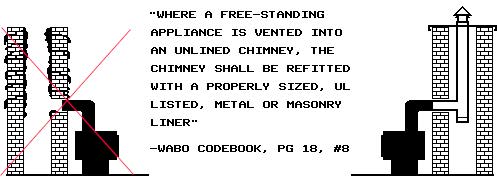
The Chimney Sweep Online Fireplace, Woodstove, Gas Stove and Barbecue Shop

The Chimney Sweep Online Fireplace, Woodstove, Gas Stove and Barbecue Shop

CODE VIOLATION: As wood exhaust passes through an unlined chimney, liquid creosote condenses onto the inner brick surfaces and attacks the bonding agent in the unprotected mortar joints. Eventually, the mortar bond is destroyed, allowing the liquid to penetrate the mortar joints. In worst cases, this highly combustible liquid can soak all the way through to the outside of the chimney structure. This soaked-in creosote can't be removed, and will likely ignite in the event of a chimney fire, resulting in open flames on the outside of the chimney. Gas exhaust contains a mixture of water and nitric acid, which also attacks unprotected mortar joints, eventually dissolving the binder. When the binder is gone, the water saturates the mortar, turning it to mush. The water soon soaks into surrounding walls, causing mold, mildew and rot. Eventually, the chimney structure collapses. Oil exhaust contains sulpheric acid, which very efficiently dissolves the binder and allows the highly combustible oily emissions to saturate the mortar joints, causing not only structural weakness, but also a fire hazard similar to that caused by soaked-in creosote. | CODE REQUIREMENT: A UL listed, stainless steel flue liner, the same diameter as the exhaust opening on the appliance, is lowered down the chimney flue and connected to a stainless steel tee, which is mortared in place at the thimble. A sealer plate at the top of the chimney creates dead-air insulation, keeping flue gases warmer and improving updraft, which reduces creosote formation. Poured or blanket insulation may be added if warmer flue temperatures are needed. A top clamp and rain cap complete the installation at the top. Flexible stainless pipe is used if there are offsets in the chimney. For gas appliances, UL listed aluminum alloy pipe is used in place of stainless steel, due to its resistance to both water damage and nitric acid corrosion, although Type 316ti stainless steel liner can also be used. Water-soaked mortar joints will often dry out and resolidify after a gas flue has been relined, restoring the structural integrity of the chimney. For oil appliances, rigid or flexible type 304, 316 or 316ti stainless pipe may be used, as all three types share a similar resistance to sulpheric acid corrosion. Insulation is used to isolate the hot liner from any soaked-in oil emissions which can't be cleaned out. |
THE BOTTOM LINE: NEVER VENT INTO AN UNLINED CHIMNEY! For more info about installing a stainless liner, click here. Note: Each Code Authority chooses the standards that regulate appliance and chimney installation and usage in their jurisdiction, and may modify code specs as
desired. The above-referenced specification is from the Washington Association of Building Officials Woodstove Installation Code Book, and may not reflect the
code requirements in your area. Contact your Code Authority for local regulations.
| |